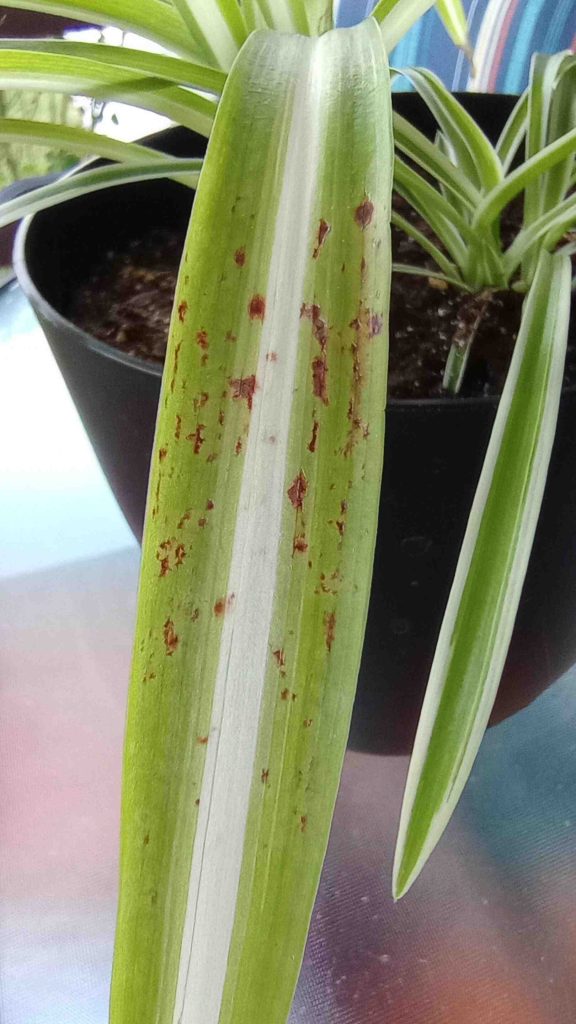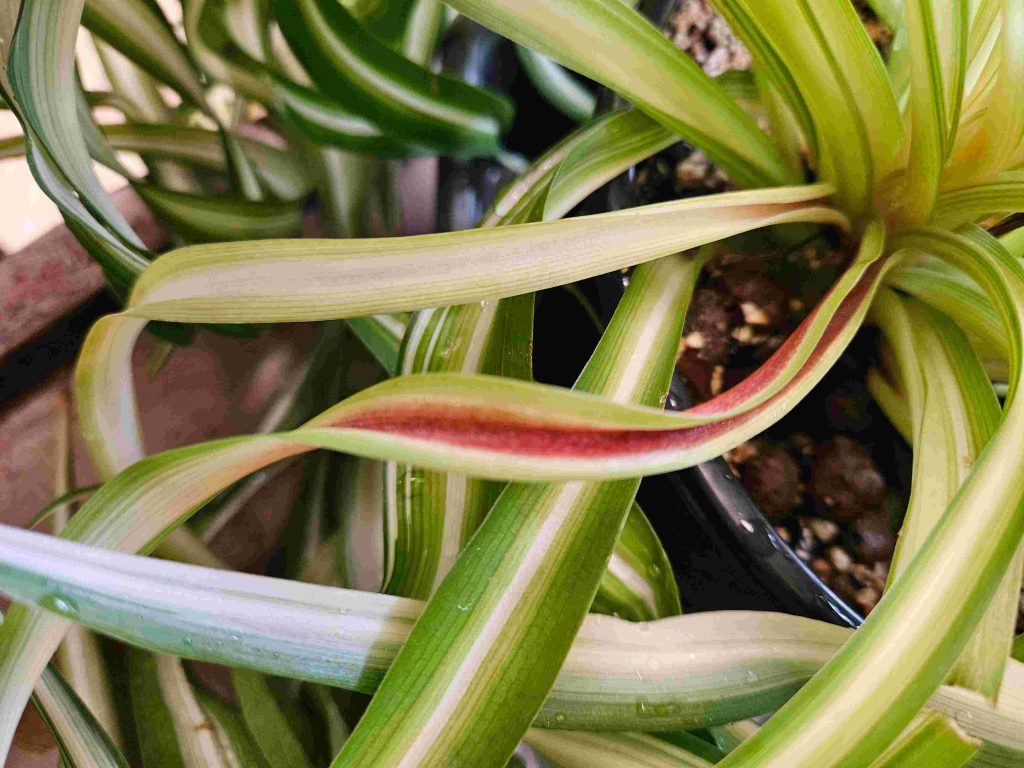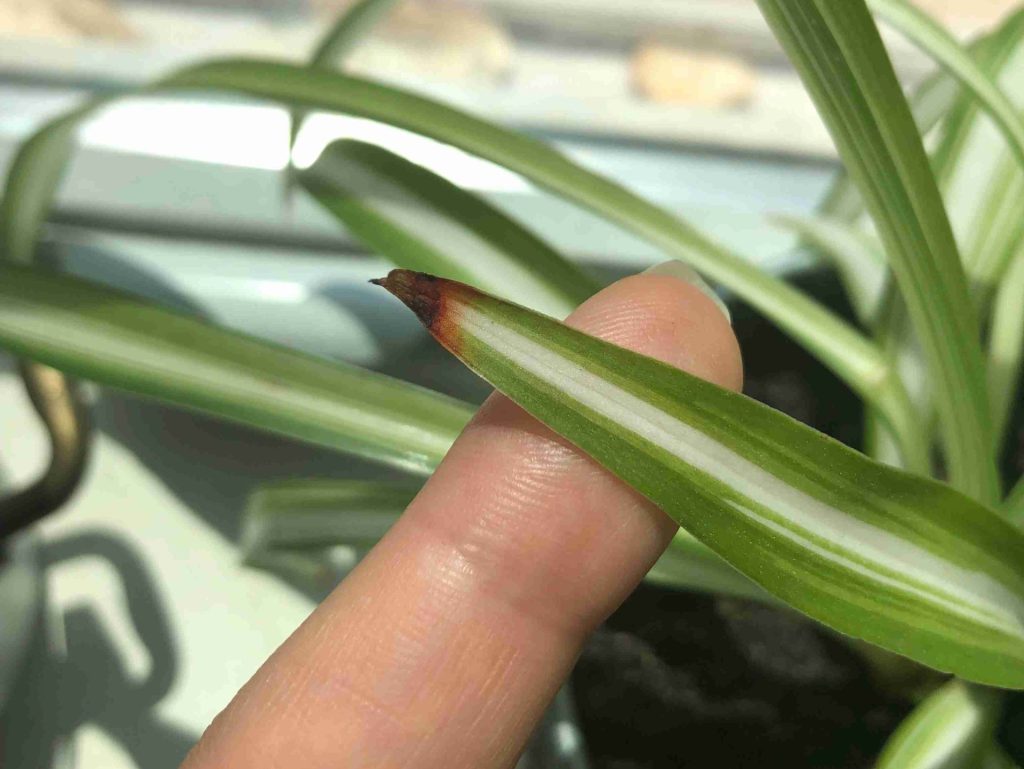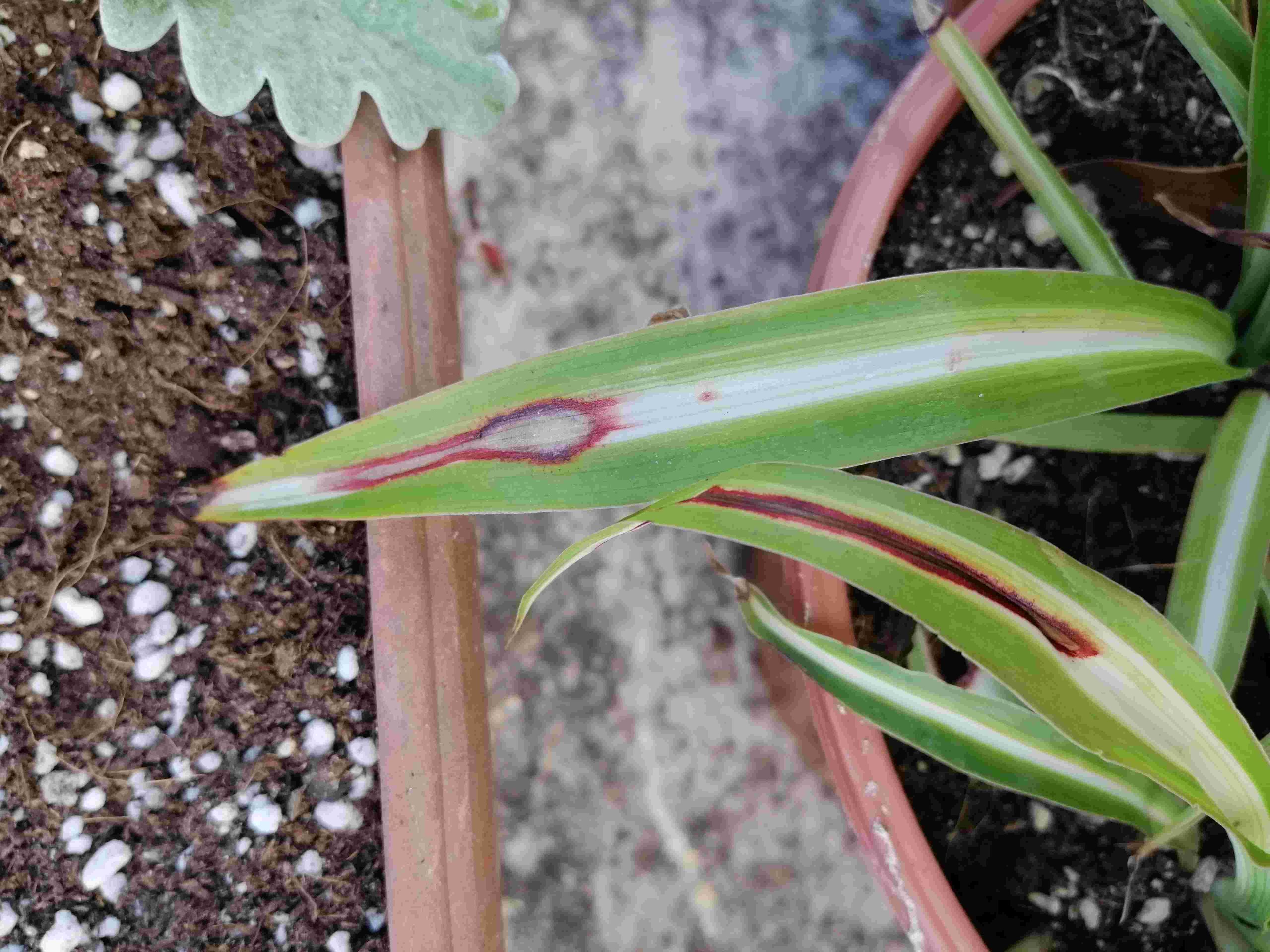Spider plants (Chlorophytum comosum) are beloved for their graceful appearance and low-maintenance care requirements, making them a popular choice for indoor gardeners. However, even the hardiest plants can occasionally encounter issues such as red spots on their leaves. These unsightly blemishes can range from subtle specks to larger blotches, detracting from the plant’s otherwise vibrant foliage. In this blog, we’ll delve into the common causes behind these red spots, offering practical solutions and preventive measures to help you maintain the health and beauty of your spider plant. Whether you’re a seasoned gardener or new to indoor plants, understanding and addressing red spots will empower you to care for your spider plant with confidence. Let’s explore the world of spider plant health together and transform those red spots into vibrant, lush green leaves once more.
What Are Red Spots on Spider Plants?
Red spots on spider plants are small, irregular discolorations that appear on the leaves, stems, or tips. These spots can vary in size and shape, ranging from tiny pinpoints to larger, blotchy areas. They are often accompanied by a yellowing of the surrounding leaf tissue, giving a mottled appearance that can be distressing for plant owners. While red spots may initially appear harmless, they can be a sign of underlying stress or an imbalance in the plant’s environment.
Understanding these red spots is crucial because they can indicate various issues—from environmental stress and pests to fungal infections and nutrient deficiencies. In some cases, these spots might develop due to a combination of factors rather than a single cause. Identifying the root cause is the first step towards effective treatment and prevention. By becoming familiar with the characteristics of these red spots and the conditions that lead to their development, you can take informed steps to address them and restore your spider plant’s health.

What are the Causes of Red Spots on Spider Plants?
Red spots on spider plants can be caused by a variety of factors, each with distinct symptoms and implications for the plant’s health. Understanding these causes is essential for diagnosing the problem accurately and implementing appropriate remedies. Here’s a closer look at the common reasons behind red spots:
Environmental Stress
Environmental stress is one of the most common culprits for red spots on spider plants. Direct sunlight, for instance, can lead to sunburn or leaf scorch, manifesting as red or brown spots. Similarly, sudden temperature fluctuations—like moving a spider plant from a warm indoor environment to a cool drafty area—can cause the leaves to develop red edges or spots as they struggle to adapt to the new conditions. Ensuring a stable environment with consistent lighting and temperatures is key to preventing such stress-induced symptoms.
Pest Infestations
Pests such as spider mites and aphids can also be responsible for red spots on spider plants. These tiny pests often hide on the underside of leaves, piercing the leaf tissue to feed on plant fluids. This feeding activity can lead to the development of red, brown, or yellow spots. Signs of a pest infestation include sticky residues (honeydew), webbing, and the presence of the pests themselves. Regular inspection of your spider plant, especially the undersides of leaves, is crucial for early detection and treatment of pest problems.

Fungal or Bacterial Infections
Fungal and bacterial infections can cause red spots on spider plants as well. Fungi such as Cercospora can cause circular, red or brown spots that may spread across the leaf, especially in conditions of high humidity and poor air circulation. Bacterial infections like leaf spot disease also lead to red or brown lesions that can enlarge and coalesce over time. These infections thrive in environments with excessive moisture, making it important to avoid splashing water onto the plant leaves and ensuring good air circulation around the plant to minimize the risk.
Nutrient Deficiencies
A lack of essential nutrients, particularly phosphorus and magnesium, can lead to red spots on spider plants. These deficiencies can manifest as red or yellow spots on the leaves, especially on the lower leaves. Phosphorus deficiency may also cause the leaves to turn purple, and magnesium deficiency can result in yellowing along leaf margins with red spots. Proper fertilization is vital for maintaining healthy plants, and using a balanced fertilizer designed for indoor plants can help correct these deficiencies.
How to Treat Red Spots on Spider Plants?
When red spots appear on your spider plant, taking prompt action is crucial to prevent further damage and encourage recovery. Addressing these spots involves a combination of environmental adjustments, pest control, and appropriate treatments for infections and deficiencies. Here’s how to treat red spots effectively:
Environmental Adjustments
- Improve Light Conditions: Ensure your spider plant is placed in an area with bright, indirect light. Direct sunlight can scorch leaves, leading to red spots. If your plant is receiving too much direct sunlight, move it to a spot with filtered or indirect light.
- Maintain Temperature: Keep your spider plant in a stable environment with temperatures ranging between 60°F to 75°F (15°C to 24°C). Avoid placing the plant near drafty windows, heaters, or air conditioning units, which can cause sudden temperature fluctuations.
- Humidity Control: Spider plants prefer moderate humidity levels. If the air in your home is dry, particularly in winter, consider using a humidifier or placing a tray of water near the plant to increase humidity around it. Misting the plant can also help maintain appropriate moisture levels, but avoid overdoing it to prevent fungal issues.
Pest Control Measures
- Inspect Regularly: Check your spider plant for pests, especially spider mites and aphids, which are common culprits of red spots. Look on the underside of leaves for tiny insects or webbing.
- Natural Remedies: For minor infestations, a strong blast of water to dislodge pests can be effective. Neem oil, diluted with water, can be sprayed directly onto the plant to repel and kill pests. Insecticidal soap is another safe option that targets pests without harming beneficial insects.
- Chemical Treatments: If the infestation is severe, use a suitable insecticide or acaricide. Always follow the manufacturer’s instructions and apply it in the early morning or late evening to avoid leaf burn and to minimize exposure to beneficial insects.

Managing Fungal/Bacterial Issues
- Prune Affected Leaves: Remove any leaves with red spots to prevent the spread of fungal or bacterial infections to healthy parts of the plant. Clean your pruning tools with alcohol or a mild antiseptic before and after use to prevent contamination.
- Fungicides: Apply a suitable fungicide if the infection persists. Look for one labeled for indoor plants and fungal diseases. It’s crucial to apply fungicides early, before the disease becomes widespread.
- Improving Air Circulation: Good air circulation around the plant is vital to prevent fungal growth. If your plant is crowded in a poorly ventilated space, consider relocating it to an area with better airflow.
Correcting Nutritional Imbalances
- Use a Balanced Fertilizer: A general-purpose indoor plant fertilizer with a balanced N-P-K ratio (e.g., 20-20-20) is ideal for spider plants. N-P-K ratio refers to ration of Nitrogen(N), Phosphorus (P) and Potassium (K) in a pre-mix fertilizer. You can find them on your nearest Plants store. Apply fertilizer according to the package instructions to avoid over-fertilizing, which can lead to leaf burn or exacerbate nutrient imbalances.
- Adjust Fertilizer Frequency: During the growing season, feed your spider plant once a month. In winter, reduce fertilization as the plant’s growth slows down.
Preventing Red Spots on Spider Plants
Prevention is always better than cure when it comes to red spots on spider plants. By understanding the common causes and implementing a few proactive measures, you can keep your plant healthy and avoid red spots altogether. Here’s how to prevent these issues:
Provide Optimal Growing Conditions
- Light: Spider plants thrive in bright, indirect light. Avoid placing them in direct sunlight for extended periods, which can lead to sunburn and red spots. Indirect light, filtered through a sheer curtain or located away from direct sun, is ideal.
- Temperature: Maintain a stable temperature range between 60°F to 75°F (15°C to 24°C). Sudden temperature changes can stress the plant and make it susceptible to red spots. Avoid placing the plant near drafty windows or doors.
- Humidity: Although spider plants are relatively tolerant of lower humidity, they prefer moderate humidity levels. Keeping the air humidity around the plant between 40% to 60% can help prevent stress and keep the leaves free from red spots.
Regular Monitoring and Maintenance
- Inspect for Pests: Regularly check your spider plant for signs of pests such as spider mites and aphids. These pests can cause red spots by feeding on the plant’s sap. Keeping the plant clean and free of dust will help make pest inspection easier.
- Watering: Watering is crucial to prevent red spots. Overwatering can lead to root rot, while underwatering can cause leaf dehydration, leading to red spots. Ensure the pot has good drainage, and allow the top inch of soil to dry out between waterings. Water when the topsoil feels dry to the touch but before the plant begins to wilt.

Proper Fertilization
- Use Balanced Fertilizer: A balanced fertilizer helps prevent nutrient deficiencies that can cause red spots. During the growing season, use a balanced, water-soluble fertilizer once a month. Be cautious not to over-fertilize, as this can lead to chemical burns on the leaves, exacerbating the problem.
- Avoid Fertilizing in Winter: During the plant’s dormant period, reduce or stop fertilizing to prevent any imbalance that may lead to red spots.
Maintain Good Hygiene and Pruning Practices
- Remove Affected Leaves: Regularly prune any leaves with red spots to prevent the spread of disease to healthy parts of the plant. Clean pruning tools with alcohol or mild antiseptic between cuts to avoid introducing pathogens.
- Maintain Cleanliness: Dust and dirt can accumulate on the leaves, making them more susceptible to pests and diseases. Clean the leaves with a damp cloth periodically to keep them free from debris and dust.
Protect from Physical Damage
- Handle with Care: Avoid rough handling when moving your spider plant. Physical damage can introduce pathogens or open up the plant to pest infestations, leading to red spots. Be gentle with your plant during watering and routine maintenance.
By following these preventive measures, you can help ensure your spider plant remains healthy and vibrant, free from red spots. Proactive care and attention to its environment will keep your plant thriving and add beauty to your indoor space.
FAQs About Red Spots on Spider Plants
Why do spider plant leaves develop red spots?
- Windy Sprouts’ Insight: Red spots on spider plant leaves can result from a variety of factors including environmental stress, pest infestations, fungal or bacterial infections, and nutrient deficiencies. These issues often lead to visible damage on the leaves, which can appear as red spots. By understanding the underlying causes—such as too much direct sunlight, improper watering, or inadequate nutrients—you can take steps to correct the problem and prevent future occurrences.
How can I tell if my spider plant has a pest infestation causing red spots?
- Windy Sprouts’ Insight: Pest infestations, such as spider mites or aphids, are common culprits behind red spots on spider plants. Signs of these pests include tiny insects on the undersides of leaves, sticky residues (honeydew), or webbing. Regularly inspect the plant for these signs and take prompt action if you detect any pest activity to prevent the red spots from spreading.
What should I do if my spider plant develops red spots due to a fungal infection?
- Windy Sprouts’ Insight: Fungal infections can cause red spots that spread across the leaf, often in humid conditions. To manage this, prune the affected leaves to prevent the fungus from spreading to healthy parts of the plant. Improve air circulation around the plant and consider using a fungicide if necessary. Be proactive in treating the infection early to protect your plant from more severe damage.
Can nutrient deficiencies cause red spots on spider plants?
- Windy Sprouts’ Insight: Yes, deficiencies in essential nutrients like phosphorus and magnesium can lead to red spots on spider plant leaves. Ensuring that your plant receives a balanced fertilizer can help prevent such deficiencies. Regularly inspect your plant’s leaves and adjust fertilization practices based on its needs to maintain optimal health and prevent red spots.
How can I prevent red spots on my spider plant?
- Windy Sprouts’ Insight: Prevention is key to keeping red spots at bay. Maintain optimal growing conditions—provide bright, indirect light, consistent temperature, and moderate humidity. Regularly check for pests, water properly, and practice good hygiene by cleaning the leaves to remove dust. Pruning any affected leaves and avoiding over-fertilizing will also help in preventing the development of red spots.
What should I do if my spider plant’s red spots don’t go away with regular care?
- Windy Sprouts’ Insight: If red spots persist despite regular care, there may be an underlying issue that requires more targeted intervention. Reevaluate your plant care routine—consider adjusting light exposure, watering habits, or fertilization. It might also be necessary to check for hidden pests or reassess your plant’s environment. If the problem continues, consulting a plant care expert can provide more tailored advice.
Conclusion
In conclusion, red spots on spider plants can be a common but manageable problem. By understanding the causes and taking preventive measures, you can ensure that your spider plant remains healthy and free from these unsightly blemishes. Whether it’s improving environmental conditions, addressing pests, or correcting nutrient deficiencies, proactive care is key to maintaining your plant’s vitality. Regular monitoring and timely intervention can prevent red spots from becoming a recurring issue, allowing your spider plant to thrive and beautify your home for years to come.
Remember, a healthy spider plant not only enhances the aesthetic appeal of your living space but also contributes to improved indoor air quality. By applying the expert tips and practices discussed in this blog, you can enjoy the lush greenery of your spider plant with confidence, knowing you’re providing the best care possible. Whether you’re a seasoned plant parent or new to indoor gardening, taking these steps will help you cultivate a thriving spider plant free from red spots.
Thank you for reading, and happy gardening!

